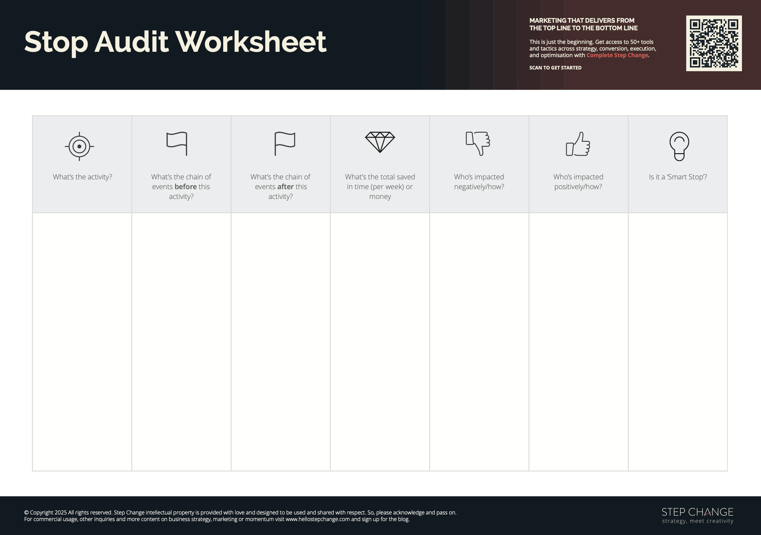Insight: Saying no to some things in order to say yes to greater things is the key to ensuring your best FY yet.
Data: About $1 million goes to waste every 20 seconds ($2 trillion per year) thanks to poor project management. (Business Wire)
Key Action Point: Protect your dollars, time, and focus by doing a Stop Audit.
Watch: Let Step Change CEO Ashton Bishop show you how to level up and protect your business with a Stop Audit.
Strategic Subtraction Beats Reactive Expansion
Take it from Apple — back in 1997, the tech giant was bloated and bleeding cash, about 90 days away from bankruptcy.
Steve Jobs returned, asking Apple design chief Jony Ive one question every day: “How many times did you say no today?”
In the end, they cut 70% of the product line, focusing on just four products: two desktops and two portables — one each for consumers and pros.
By 1998, Apple flipped a massive $1 billion loss into a $309 million profit. The iMac G3 — bold, beautiful, and all-in-one — sold 800,000 units in five months and helped reignite the brand.
The move? Ruthless focus. The result? Category leadership.
The bottom line is, strategic subtraction beats reactive expansion, every time. In today’s market, you either prioritise or perish.
So when Steve Jobs said, “I'm as proud of what we don't do as I am of what we do,” you know he meant it. Because saying no comes with:
- Sharper focus and efficiency by freeing up resources for what really matters
- Higher profitability by doubling down on work with the greatest return
- Better customer outcomes by prioritising what truly serves your market
- Lower risk exposure by avoiding distractions that could cost more than they’re worth
Related: Invest with Confidence: 6 Questions to Unlock Business Opportunities
Run a Strategic EOFY Stop Audit in 5 Steps
Step Change’s Stop Audit cuts the noise and sharpens strategic focus. We use it ourselves, and our clients are unlocking serious value from it, too. Here’s how to run it in your business.
Step 1. Get into Teams of Two or Three
Create small, focused units across departments. This builds psychological safety and cross-functional insight.
Step 2. Map Out Your Typical Week
Walk through your Monday-to-Friday rhythm. Note meetings, recurring tasks, projects, approvals — anything that consumes time or focus. Pay attention to:
- Legacy meetings no one owns
- Tasks that never get reviewed for impact
- Work that’s always done “because we always have”
Step 3. Use the Stop Audit Worksheet
Introduce a simple flowchart or matrix that plots activities against:
- Value delivered
- Strategic alignment
- Required resources
- Energy cost

Step 4. Identify Smart Stops
A Smart Stop clears the way for more valuable work. Ask:
- Does it align with my priorities? If a project or an event doesn’t fit in your long-term or short-term priorities, you might as well turn down the invitation.
- Does it align with my values? When you are offered a partnership or a project, check your company values or the personal values you uphold.
- Am I the right person to work on it? Check if you’re the right person for the task. Is there someone else or another department best equipped to handle the project?
- Do I have everything I need to get started? There’s no point starting a project or a task if you don’t have all the necessary information in order to deal with it.
Step 5. Gamify the Audit
Turn clarity into a competition:
- Award points for each high-impact stop
- Celebrate the team that finds the biggest strategic gain
- Run it monthly to make strategic culling a habit
Gamification turns what feels like sacrifice into empowerment — especially when results are visible.
Tying It Together
Not all opportunities are created equal. Some yeses move you forward, others just weigh you down.
In fast-paced organisations, it’s easy to take on so much — until your team is drowning in deliverables, clarity is lost, and strategic focus slips through the cracks.
When everything’s a priority, nothing truly is. The risk? Burnout, bloated calendars, and diluted impact.
The Stop Audit is your chance to reset. To step back, assess what’s working, and deliberately cut what’s not.
Run this audit for your business and gain sharper focus, free up critical resources, and create space for the work that truly moves the needle.
Because real growth doesn’t come from doing more — it comes from doing what matters most.









